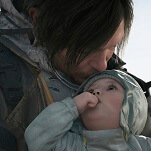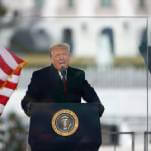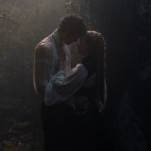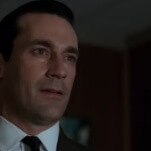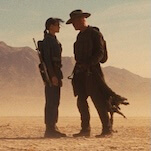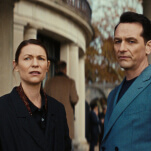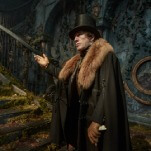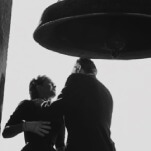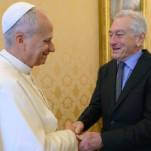Witness In The Myst
This week saw the release of The Witness, the long-awaited follow-up to Braid from designer Jonathan Blow. In an equally long-awaited review, John Teti praised the game’s ability to consistently lead players toward true, powerful epiphanies as they work out the hundreds of puzzles on its mysterious island. It has garnered many comparisons to Myst, and understandably so. Both are first-person games where you wander a weird island solving puzzles and wondering about the nature of the place. ItsTheShadsy points out that, on the surface, The Witness’ line-drawing puzzles don’t seem to be derived from a point of practical and historical significance to their surroundings, something the Myst series did very well:
That the puzzles in The Witness appear to be mostly uninformed by an environmental story is a confusing choice because of how strongly Myst excels at that. It sounds like it draws on a different vein of satisfaction, one that almost positions the game as a rationalist counterpoint to the series of its inspiration. And it helps me appreciate both games more.
In my mind, the greatest puzzle in game history is the secret behind the glyphs found in Riven, the second Myst title. Throughout the game, you discover these odd square-shaped drawings scattered throughout the island; they have some apparent meaning but no context. Later, when you visit an abandoned village, you can enter the town schoolhouse and play with a child’s counting game—and you realize that the glyphs are actually a number system. It’s a beautiful, revelatory, spiritual moment: Yes, you learn the solution to a major question, but in a way that deeply connects you to the setting and its culture. Uncovering the symbols’ meaning feels less like unlocking an achievement than speaking a new language.
So when it seemed like the bulk of The Witness was abstract logic puzzles, I soured on it. Why even bother aping Myst while ignoring the meaning-driven challenges that make it so powerful?
Based on what John said, especially about how the puzzles resemble schools of thought, The Witness does still seem to provide that deep sense of connection, but in a way that appeals to reason. Like when an astronomer marvels at the sprawl of the universe, finding beauty and peace existing among patterns and systems. Understanding those systems more thoroughly is still a source of great personal satisfaction—based in broadening knowledge rather than finding kinship of souls.
John mention that the game includes quotes from great historical thinkers. It makes perfect sense as the other side of the coin to Myst. Myst‘s creators, Rand and Robyn Miller, are both deeply religious, and there has been a good deal of discussion about whether that influences the games’ themes. It did, and I never understood that until reading this review. Myst uses puzzles to find a sense of communal experience. The Witness uses them to help us appreciate human achievement.
But George Lopez Dispenser, and several other commenters, disagreed about The Witness’ puzzles not being harmonious with their setting, something that’s difficult to grasp without having played the game:
It is extremely hard to explain without spoiling the game, but the puzzles are not just scattered around the world haphazardly, or “layered” on top of the art assets. They seem to have been placed very deliberately within the fiction of the world—not just by the game’s designers. A tiny example that you’ll notice very early: Some puzzle panels are old CRT-looking things, and some are super slick see-through glass displays; sometimes you’ll notice one of the new ones placed in the middle of a bank of old ones, like someone came along and “revised” the puzzle sequence after many years. That seems small, but little clues like that add up. By the end, you realize the story of the island and the puzzles are closely intertwined.
ErikaeBatayz gave the world design and storytelling similar praise, while also applauding the game’s wordless teaching methods:
I’m about 10 hours deep into this game right now, and I’ve got to say: It’s the real deal, an absolute masterpiece of design. I’ve completed around 350 of the supposedly more than 600 puzzles in the game, and it is absolutely astonishing how much depth and variety Blow and his team manage to get out of the line drawing conceit. The way concepts are introduced, then twisted, then built upon, then combined with other concepts, then built upon some more—all without a single second of tutorial text—is masterfully done. It’s obvious that a significant amount of time and thought was put into every aspect of the game’s design, and it totally payed off. I’ve lost track of the number of times I’ve banged my head against a seemingly impossible puzzle only to have that lightbulb moment (something in the environment I was missing, some aspect of the rule-set I hadn’t fully grasped, etc.) and be left feeling totally brilliant and satisfied. That’s a direct result of the game’s meticulous design. Concepts are doled out and expanded upon at such a perfect pace that you are constantly expanding your knowledge and skillset as you progress.
This is not, as some people have suggested, a glorified iPhone game pasted onto a pretty island. The world and the puzzles are inextricably linked and play off of each other in satisfying and interesting ways. And that doesn’t even include all of the secrets hidden outside of the puzzle panels, which are best discovered on your own. Trust me.
Paper Monarchy
On the other side of the week and the video game seriousness spectrum, I reviewed the latest Mario role-playing game, Mario & Luigi: Paper Jam, in which the cast of the Paper Mario games invades the 3D cartoon world of the Mario & Luigi games. I mentioned a memorable, poignant conversation between its two Princess Peach characters, where both bemoan their seeming inability to make choices for themselves rather than buckle to outside pressures. As The Space Pope points out, this is kind of strange, considering Princess Peach is the only ruling party we’re introduced to in the Mario games (outside of those kings in Mario Bros. 3, who were never seen again):
I’m saddened by the dual Princess Peaches’ yearning for freedom. Are they not aware that they’re the sole authorities in their respective kingdoms? In most cases, anyone who tells an absolute monarch that her hair isn’t good enough can look forward to an all-expenses-paid vacation to the dungeons. Why do the Peaches feel the need to put up with this nonsense? Perhaps they’ve forgotten Machiavelli’s precepts and focused too much on being loved to care about being feared. It’s a good fault to have, but still, the means of their liberation is in their hands already, and they only need to find the strength to use it. Maybe they should hang out with Adventure Time‘s Princess Bubblegum. She’d have an interesting perspective on all this.
Being sick of having to be rescued all the time, on the other hand, makes perfect sense. That’s gotta be a drag. Perhaps it was the frequent captivity that produced their feelings of helplessness in their everyday lives. Were Bowser’s seemingly fruitless kidnappings really an extended exercise in psychological warfare, meant more to gradually weaken his political rival than to seek short-term gain? He’s even more diabolical than we thought!
Duwease thinks Peach is just a figurehead:
Peach hasn’t had absolute power in decades. Sure, she’s a powerful symbol, but the older Toads obviously call the shots. She’s mainly a figurehead at this point, going through the motions of the “kidnapping of the week” to keep the lavish lifestyle afloat on tabloid money. Those coins in the sky don’t hang themselves.
And Venerable Monk hopes there’s a little more meaning to this Paper Jam scene:
I would hope that the devs included this conversation as a not-so-subtle dig at the brand consistency enforced by Nintendo. When you get down to it, it’s not the Mushroom Kingdom that’s making sure the characters are mostly static copies of their earliest iterations. Even though pretty much all of the main characters remain unchanged from one game to the next, at least the dudes get to occupy a variety of roles within the Kingdom.
That does it for this week, Gameologerinos. Thank you for reading and commenting. We’ll see you all next week!

